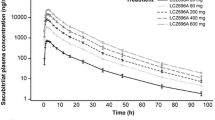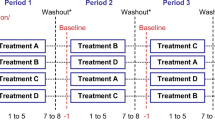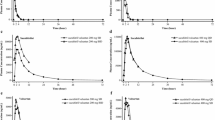Abstract
Objective: Valsartan (V), a specific inhibitor of the angiotensin II receptor subtype, AT1, has been developed for treatment of hypertension. Combination therapy with a β-adrenoceptor blocking agent might be considered in cases with insufficient efficacy of V alone. Therefore, an interaction trial was performed to evaluate the effects of co-administration of V on the pharmacokinetics of atenolol (A), and vice versa, and to monitor the pharmacodynamic response of plasma angiotensin II (ANG II) concentrations and plasma renin activity (PRA), as well as of heart rate and blood pressure, under resting and exercise conditions.
Methods: Twelve healthy, normotensive, male volunteers aged 23–46 years were treated with single doses of either 160 mg V or 100 mg A alone, or with both drugs in combination (V+A) according to a three-period crossover design. Plasma concentrations of V and A were determined using HPLC with fluorimetric and UV detection, respectively, and concentration-time profiles were established over 24 h. Plasma ANG II concentrations and PRA were monitored using specific radio-immunoassays. Heart rate and blood pressure were measured at rest and during exercise on a cycle ergometer at a workload of 2.5 W/kg−1.
Results: For V, mean AUC and Cmax were slightly higher when A was co-administered, the ratios of log transformed values being 1.13 and 1.22 for AUC(0–inf) and Cmax, respectively. For A, mean AUC and Cmax were slightly lower when the drug was given in combination with V. The ratios of log-transformed values in this case were 0.90 and 0.92, respectively. The sharp increase in plasma ANG II concentrations and PRA, induced by administration of V, was significantly attenuated when the drug was combined with A. In the first 12 h after drug intake, heart rate and systolic blood pressure at rest were significantly decreased when V and A were co-administered compared with treatment with V alone. V given alone did not influence heart rate or systolic blood pressure during exercise, whereas A alone and V+A led to a significant reduction in those variables. Adverse experiences reported after A and V+A could be explained by the high degree of β-adrenoceptor blockade resulting from the administration of A.
Conclusions: Co-administration of single doses of V and A does not modify the pharmacokinetics of the two drugs to a clinically relevant degree. With respect to pharmacodynamics, a single dose of A attenuates the increase in plasma ANG II and PRA in response to a single dose of V, and V has no effect on the hemodynamic response to exercise. The combined treatment with single doses of 160 mg V and 100 mg A has some additive effects on resting blood pressure in healthy, normotensive subjects.
Similar content being viewed by others
Author information
Authors and Affiliations
Additional information
Received: 17 September 1996 / Accepted in revised form: 21 March 1997
Rights and permissions
About this article
Cite this article
Czendlik, C., Sioufi, A., Preiswerk, G. et al. Pharmacokinetic and pharmacodynamic interaction of single doses of valsartan and atenolol. E J Clin Pharmacol 52, 451–459 (1997). https://doi.org/10.1007/s002280050318
Issue Date:
DOI: https://doi.org/10.1007/s002280050318




